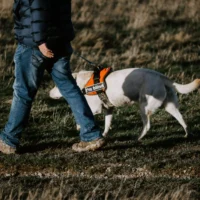Did you know that the Seeing Eye Dog celebration day is January 29th? Seeing Eye Dogs, or guide dogs, as they are also called, are pups that have been specially trained to serve as the eyes of their owners. A local Hobe Sound, FL veterinarian discusses these remarkable canines in this article.
What Tasks Can Seeing Eye Dogs Perform?
Guide dogs are trained to assist their human companions in many different ways. Some common tasks include crossing streets, maneuvering around obstacles, and navigating uneven terrain, like curbs or hills. They also guide their humans around things like parking meters, lamp posts, open manholes, and low-hanging awnings or branches. Moreover, they can lead their humans into or out of buildings or rooms, locate elevators, and find available seating. Finally, they can retrieve specific items like mail or medication for their owners.
How Do Guide Dogs Do Their Work?
The key is something called intelligent disobedience. Unlike other trained dogs, guide dogs aren’t supposed to always follow orders. When a guide dog sees a potential hazard, it will refuse to move forward, regardless of the command it receives from its owner. Fido may stop or sit suddenly if something dangerous approaches, such as a car or bicyclist, or if he and his owner approach an obstacle, such as a curb, stairwell, or another barrier.
What Is The Origin Of The Seeing Eye Dog?
Believe it or not, our canines may have been helping humans in this capacity for over two thousand years! Art found in the ancient Roman village of Herculaneum, which was buried in the infamous Mount Vesuvius eruption way back in 79 C.E., shows a dog guiding a blind man. Similar records have been found in records from Asia and Europe, including several that date back to the Middle Ages.
More recently, a 16th-century alphabet rhyme contains the line, ‘B was a blind man led by a dog.’ Elizabeth Barret Browning also mentioned guide dogs in her 19th-century work Aurora Leigh.
Later, in the aftermath of World War I, German guide dog training schools were set up to help veterans blinded by mustard gas. This started with a doctor named Gerhard Stalling. One day, he was walking with his dog and a patient when he was suddenly called away. He left the two together for a short time. Upon his return, he found the dog assisting the human. This sparked his curiosity, leading him to explore the concept further and ultimately resulting in the creation of the first guide dog school in 1916. The school’s success spread quickly, with branches opening in Bonn, Breslau, Hamburg, Magdeburg, Münster, Dresden, Essen, Freiburg, and Hannover. At its peak, the institute was training up to 600 dogs annually, helping individuals not only in Germany but also in other countries such as Britain, France, Spain, Italy, the United States, Canada, and the Soviet Union. Although these particular schools eventually closed down, they paved the way for similar institutions.
Why Is The Seeing Eye Dog’s Birthday Celebrated on January 29th?
A wealthy trainer named Dorothy Eustis established the Seeing Eye training center on January 29, 1929, along with a man named Morris Frank. Frank had lost the vision in both eyes through two separate accidents. (Interestingly, his mother also lost sight in her eyes due to two unrelated incidents, though in her case it was childbirth and a fall.)
After reading an article Eustis had written on guide dogs, Frank reached out to her and asked for her assistance in training a dog for him. She agreed, and they trained an outstanding canine named Buddy. The pooch became a media sensation when the team arrived in New York City in 1928. (Fun fact: Frank owned three guide dogs in his lifetime, all of whom were German Shepherds named Buddy.) Eustis and Frank went on to found The Seeing Eye, and the rest is history.
How Are Guide Dogs Trained?
Fido needs to begin training at an early age, long before meeting his prospective owners. The process of partnering a dog and a human can be quite time-consuming. Finding the right match is crucial! Fido usually starts working around the age of one and a half.
Most guide dogs’ careers last about 8 to 10 years. After that, these very good boys (and girls) typically ‘retire’ to the life of being a pet, sometimes with adoptive families. This may sound sad, but it’s best for both parties. Fido gets to enjoy a good retirement, while the owner—who is still in need—will be paired with another dog.
Is There A Difference Between Seeing Eye Dogs And Guide Dogs?
This is mostly a case of technicalities. It’s probably safe to say that most people don’t know this, but the term Seeing Eye Dog is trademarked, and should only be used for dogs trained by The Seeing Eye school. Dogs trained by other schools are referred to as guide dogs.
That said, there is a clear contrast between guide dogs and emotional support animals. Guide dogs are classified as service dogs, so they are legally protected by federal law. With the exception of some sterile environments, such as laboratories and certain hospital units, they have access to almost all locations. Ask your Hobe Sound, FL veterinarian for more information.
What Breed Of Dog Is The Seeing Eye Dog?
Numerous breeds of dogs excel as Seeing Eye Dogs, with common choices being Labrador Retrievers, Golden Retrievers, and German Shepherds. Border Collies, Standard Poodles, Vizslas, Australian Shepherds, Boxers, and Airedales also do well here. While not officially recognized breeds, Doodle dogs like Labradoodles and Goldendoodles are also popular in this line, and are often sought after for their hypoallergenic coats. If you’re interested in learning more about one of these popular breeds, check out our article where A Jupiter Island, FL Veterinarian Discusses The Golden Retriever.
How Bad Does Your Vision Have To Be To Get A Seeing Eye Dog?
You must be legally blind (your visual acuity must be 20/200 or less, even with vision correction, such as glasses or contacts). Some programs allow you to apply for guide dogs at the age of 17 if you are 18 or older.
How Much Do Seeing-Eye Dogs Cost?
Costs can reach up to $50,000 annually. It is important to note that Medicare, Medicaid, and other insurance plans generally do not cover Fido’s training and care costs. However, there may be alternative funding options available, including utilizing FSA or HSA accounts. Funding, grants, personal savings, and loans are also viable options. Some guide dog institutes function as charities, and may offer assistance, but their eligibility requirements may vary.
Is It Okay If I Pet A Seeing Eye Dog?
It’s a hard no on this one! Fido may be adorable, but if you see him out and about, he’s working and must be allowed to focus on helping his person. Additionally, as mentioned above, guide dogs are protected by federal law. It’s illegal to interfere with their work.
The only exception is when a service dog approaches you. It may be a sign that the owner is in trouble. Call 911 and follow the dog if you can safely do so. Ask your vet for more information.
Have questions about dog care? Is your pet due for an exam? Contact us, your local Hobe Sound, FL pet hospital, today! We offer a range of services to keep your canine companion healthy, including veterinary diagnostics to ensure early detection and treatment of any potential health issues. Our team is committed to providing the best care for all dogs, whether they’re working as guide dogs or simply being beloved pets.




